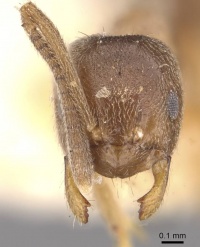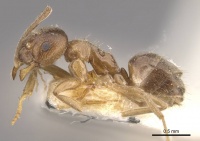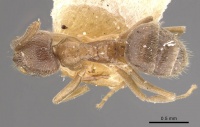Paraparatrechina aseta
| Paraparatrechina aseta | |
|---|---|

| |
| Scientific classification | |
| Kingdom: | Animalia |
| Phylum: | Arthropoda |
| Class: | Insecta |
| Order: | Hymenoptera |
| Family: | Formicidae |
| Subfamily: | Formicinae |
| Tribe: | Lasiini |
| Genus: | Paraparatrechina |
| Species: | P. aseta |
| Binomial name | |
| Paraparatrechina aseta (Forel, 1902) | |
Identification
Distribution
Latitudinal Distribution Pattern
Latitudinal Range: 32.474167° to 32.474167°.
| North Temperate |
North Subtropical |
Tropical | South Subtropical |
South Temperate |
- Source: AntMaps
Distribution based on Regional Taxon Lists
Oriental Region: India (type locality).
Palaearctic Region: China.
Distribution based on AntMaps
Distribution based on AntWeb specimens
Check data from AntWeb
Countries Occupied
| Number of countries occupied by this species based on AntWiki Regional Taxon Lists. In general, fewer countries occupied indicates a narrower range, while more countries indicates a more widespread species. |

|
Estimated Abundance
| Relative abundance based on number of AntMaps records per species (this species within the purple bar). Fewer records (to the left) indicates a less abundant/encountered species while more records (to the right) indicates more abundant/encountered species. |

|
Biology
Castes
Nomenclature
The following information is derived from Barry Bolton's Online Catalogue of the Ants of the World.
- aseta. Prenolepis aseta Forel, 1902d: 292 (w.) INDIA. Combination in Pr. (Nylanderia): Emery, 1914f: 422; in Paratrechina (Nylanderia): Emery, 1925b: 219; in Nylanderia: LaPolla, Brady & Shattuck, 2010a: 127; in Paraparatrechina: Bharti & Wachkoo, 2014: 97.
Description
Unless otherwise noted the text for the remainder of this section is reported from Bharti & Wachkoo, 2014.
Worker
Head: Head subrectangular; longer than wide, slightly wider posteriorly than in front, lateral margins gently convex, posterior margin concave with rounded posterolateral corners. Clypeus carinate in the middle; anterior clypeal margin medially concave. Mandibles with six teeth. Eyes broadly oval, flattened, weakly convex to just flat, covering approximately one-fourth of lateral cephalic margin; three small ocelli present. Antennae short, scapes surpass posterior margin by about one-fourth their length.
Mesosoma: Metanotal groove weakly developed, in lateral view not interrupting the continuous, flat dorsal margin; metanotal area indistinct. Propodeal declivity rounding onto the sides through a blunt angle. Petiole. Petiole low, with straight to broadly rounded scale, inclined forward, strongly compressed anteroposteriorly.
Sculpture: Overall cuticle dull and opaque covered with fine punctulae. Clypeus, mesopleuron and propodeal declivity smooth and shiny. Vestiture: Pubescence fine and short giving a pruinose appearance to the head and gaster, less so to the mesosoma. Scapes and legs lacking macrosetae, but a layer of pubescence present. Macrosetae shorter on head posterior to eyes and gaster, longer on anterior of head and mesosoma. Two pairs of macrosetae present on propodeum. Color: Uniformly light brown.
Measurements (n = 12): TL 2.05-2.17; HL 0.54-0.58; HW 0.46-0.48; EL 0.12-0.14; SL 0.50-0.53; PW 0.34-0.37; PrFL 0.42-0.47; PrFW 0.12-0.13; WL 0.59-0.66; GL 0.91-0.94. Indices: CI 83.21-86.54; SI 106.05-112.16; REL 22.00-25.51.
References
- Bharti, H. & Wachkoo, A.A. 2014. New combination for a little known Indian ant, Paraparatrechina aseta (Forel, 1902) comb. n. (Hymenoptera: Formicidae). Journal of the Entomological Research Society, 16, 95-99.
- Emery, C. 1914f. Les fourmis de la Nouvelle-Calédonie et des îles Loyalty. Nova Caled. A Zool. 1: 393-437 (page 422, Combination in Pr. (Nylanderia))
- Emery, C. 1925d. Hymenoptera. Fam. Formicidae. Subfam. Formicinae. Genera Insectorum 183: 1-302 (page 219, Combination in Paratrechina (Nylanderia))
- Forel, A. 1902d. Variétés myrmécologiques. Ann. Soc. Entomol. Belg. 46: 284-296 (page 292, worker described)
References based on Global Ant Biodiversity Informatics
- Bharti H., Y. P. Sharma, M. Bharti, and M. Pfeiffer. 2013. Ant species richness, endemicity and functional groups, along an elevational gradient in the Himalayas. Asian Myrmecology 5: 79-101.
- Forel A. 1902. Variétés myrmécologiques. Ann. Soc. Entomol. Belg. 46: 284-296.
- Forel A. 1906. Les fourmis de l'Himalaya. Bulletin de la Société Vaudoise des Sciences Naturelles 42: 79-94.
- Guénard B., and R. R. Dunn. 2012. A checklist of the ants of China. Zootaxa 3558: 1-77.
- Li Z.h. 2006. List of Chinese Insects. Volume 4. Sun Yat-sen University Press
- Ran H., and S. Y. Zhou. 2012. Checklist of chinese ants: formicomorph subfamilies (Hymenoptera: Formicidae) II. Journal of Guangxi Normal University: Natural Science Edition 30(4): 81-91.
- Tak N., and N. S. Rathore. 1996. Ant (Formicidae) fauna of the Thar Desert. Pp. 271-276 in: Ghosh, A. K.; Baqri, Q. H.; Prakash, I. (eds.) 1996. Faunal diversity in the Thar Desert: gaps in research. Jodhpur: Scientific Publishers, xi + 410 pp.
- Tak N., and N. S. Rathore. 2004. Insecta: Hymenoptera: Formicidae. State Fauna Series 8: Fauna of Gujarat. Zool. Surv. India. Pp. 161-183.
- Tak N., and S. I. Kazmi. 2013. On some ants (Insecta: Hymenoptera: Formicidae) from Nagaland, India. Rec. zool. Surv. India: 113(1): 169-182.
- Tak, N. 2009. Ants (Hymenoptera: Formicidae) of the Thar Desert of Rajasthan and Gujarat. in C. Sivaperuman et al. (eds.), Faunal Ecology and Conservation of the Great Indian Desert
- Zhang W., and S. Zhou. 2016. An investigation on Formicidae species of Nanling National Park. Journal of Huizhou University 36(3): 27-30.
- Zhou S.-Y. and Zheng Z. 1998. Three new species and a new record species of tribe Prenolepidini (Hymenoptera: Formicidae) from Guangxi, China. Entomologia Sinica 5(1): 42-46

